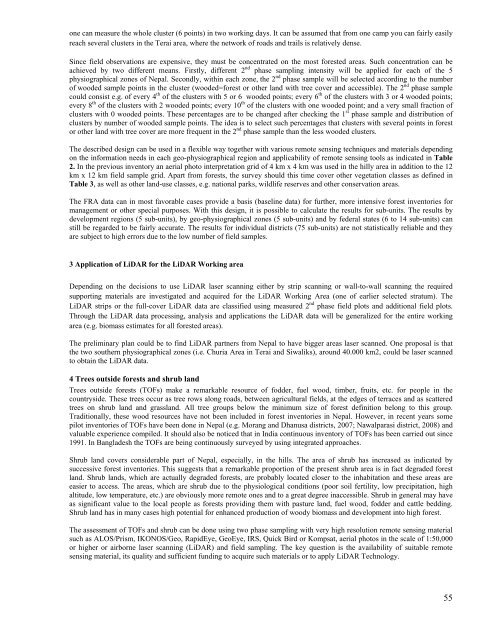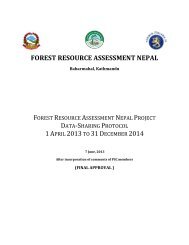Download - FRA Nepal
Download - FRA Nepal
Download - FRA Nepal
You also want an ePaper? Increase the reach of your titles
YUMPU automatically turns print PDFs into web optimized ePapers that Google loves.
one can measure the whole cluster (6 points) in two working days. It can be assumed that from one camp you can fairly easily<br />
reach several clusters in the Terai area, where the network of roads and trails is relatively dense.<br />
Since field observations are expensive, they must be concentrated on the most forested areas. Such concentration can be<br />
achieved by two different means. Firstly, different 2 nd phase sampling intensity will be applied for each of the 5<br />
physiographical zones of <strong>Nepal</strong>. Secondly, within each zone, the 2 nd phase sample will be selected according to the number<br />
of wooded sample points in the cluster (wooded=forest or other land with tree cover and accessible). The 2 nd phase sample<br />
could consist e.g. of every 4 th of the clusters with 5 or 6 wooded points; every 6 th of the clusters with 3 or 4 wooded points;<br />
every 8 th of the clusters with 2 wooded points; every 10 th of the clusters with one wooded point; and a very small fraction of<br />
clusters with 0 wooded points. These percentages are to be changed after checking the 1 st phase sample and distribution of<br />
clusters by number of wooded sample points. The idea is to select such percentages that clusters with several points in forest<br />
or other land with tree cover are more frequent in the 2 nd phase sample than the less wooded clusters.<br />
The described design can be used in a flexible way together with various remote sensing techniques and materials depending<br />
on the information needs in each geo-physiographical region and applicability of remote sensing tools as indicated in Table<br />
2. In the previous inventory an aerial photo interpretation grid of 4 km x 4 km was used in the hilly area in addition to the 12<br />
km x 12 km field sample grid. Apart from forests, the survey should this time cover other vegetation classes as defined in<br />
Table 3, as well as other land-use classes, e.g. national parks, wildlife reserves and other conservation areas.<br />
The <strong>FRA</strong> data can in most favorable cases provide a basis (baseline data) for further, more intensive forest inventories for<br />
management or other special purposes. With this design, it is possible to calculate the results for sub-units. The results by<br />
development regions (5 sub-units), by geo-physiographical zones (5 sub-units) and by federal states (6 to 14 sub-units) can<br />
still be regarded to be fairly accurate. The results for individual districts (75 sub-units) are not statistically reliable and they<br />
are subject to high errors due to the low number of field samples.<br />
3 Application of LiDAR for the LiDAR Working area<br />
Depending on the decisions to use LiDAR laser scanning either by strip scanning or wall-to-wall scanning the required<br />
supporting materials are investigated and acquired for the LiDAR Working Area (one of earlier selected stratum). The<br />
LiDAR strips or the full-cover LiDAR data are classified using measured 2 nd phase field plots and additional field plots.<br />
Through the LiDAR data processing, analysis and applications the LiDAR data will be generalized for the entire working<br />
area (e.g. biomass estimates for all forested areas).<br />
The preliminary plan could be to find LiDAR partners from <strong>Nepal</strong> to have bigger areas laser scanned. One proposal is that<br />
the two southern physiographical zones (i.e. Churia Area in Terai and Siwaliks), around 40.000 km2, could be laser scanned<br />
to obtain the LiDAR data.<br />
4 Trees outside forests and shrub land<br />
Trees outside forests (TOFs) make a remarkable resource of fodder, fuel wood, timber, fruits, etc. for people in the<br />
countryside. These trees occur as tree rows along roads, between agricultural fields, at the edges of terraces and as scattered<br />
trees on shrub land and grassland. All tree groups below the minimum size of forest definition belong to this group.<br />
Traditionally, these wood resources have not been included in forest inventories in <strong>Nepal</strong>. However, in recent years some<br />
pilot inventories of TOFs have been done in <strong>Nepal</strong> (e.g. Morang and Dhanusa districts, 2007; Nawalparasi district, 2008) and<br />
valuable experience compiled. It should also be noticed that in India continuous inventory of TOFs has been carried out since<br />
1991. In Bangladesh the TOFs are being continuously surveyed by using integrated approaches.<br />
Shrub land covers considerable part of <strong>Nepal</strong>, especially, in the hills. The area of shrub has increased as indicated by<br />
successive forest inventories. This suggests that a remarkable proportion of the present shrub area is in fact degraded forest<br />
land. Shrub lands, which are actually degraded forests, are probably located closer to the inhabitation and these areas are<br />
easier to access. The areas, which are shrub due to the physiological conditions (poor soil fertility, low precipitation, high<br />
altitude, low temperature, etc.) are obviously more remote ones and to a great degree inaccessible. Shrub in general may have<br />
as significant value to the local people as forests providing them with pasture land, fuel wood, fodder and cattle bedding.<br />
Shrub land has in many cases high potential for enhanced production of woody biomass and development into high forest.<br />
The assessment of TOFs and shrub can be done using two phase sampling with very high resolution remote sensing material<br />
such as ALOS/Prism, IKONOS/Geo, RapidEye, GeoEye, IRS, Quick Bird or Kompsat, aerial photos in the scale of 1:50,000<br />
or higher or airborne laser scanning (LiDAR) and field sampling. The key question is the availability of suitable remote<br />
sensing material, its quality and sufficient funding to acquire such materials or to apply LiDAR Technology.<br />
55





